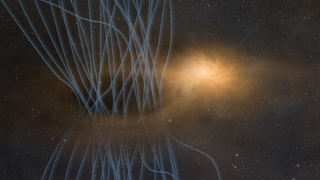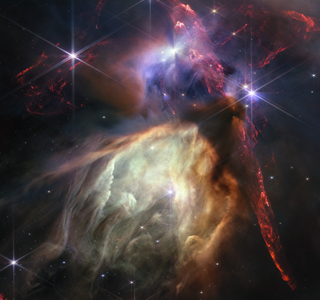
An illustration of a protostar “sneezing” and expelling gas, dust, and magnetic fields
(Image credit: ALMA (ESO/NAOJ/NRAO))
Every new parent knows the cold anxiety that grips them when their baby sneezes for the first time. That’s when a litany of possible issues and ailments probably begin to irrationally race through your mind. Researchers now know baby stars also “sneeze,” but these infinitely more powerful post-natal sneezes launch gas, dust, and magnetic energy. In other words, they’re more useful to the cosmos than stressful.
These eruptions from so-called “protostars” are actually a vital part of stellar development, and can tell scientists a great deal about that stellar body’s evolution and maybe even if it will one day be surrounded by planets. Imagine a baby sneezing and their parents knowing from this they will one day be an architect.
The stellar sneezes were discovered by a team of scientists from Kyushu University in Japan who used the Atacama Large Millimeter/submillimeter Array (ALMA) to study the disks of gas and dust that surround infant stars that collapse to birth planets. These disks are called “protostellar disks.”
Related: Hidden star discovery reveals ‘old smokers’ and ‘screaming’ newborns
Sneezing in stellar nurseries
All stars are born when dense and cool patches of material gather in massive clouds of interstellar gas and dust. These clumps gather mass and eventually collapse to birth protostars surrounded by a protostellar disk of matter.
Protostars continue to gather mass while gobbling up yet more matter from their surroundings — this goes on until the pressure at their cores is sufficient to trigger the nuclear fusion of hydrogen to helium. This process defines a fully-fledged main sequence star, like the sun. Around 4.6 billion years ago, our own star would have been going through this very birthing and growing process. There is a problem, however.
The magnetic fields of these infant systems are far greater than those of protostars.
“These structures are perpetually penetrated by magnetic fields, which brings with it magnetic flux,” team leader and Kyushu University scientist Kazui Tokada said in a statement. “However, if all this magnetic flux were retained as the star developed, it would generate magnetic fields many orders of magnitude stronger than those observed in any known protostar.”
Breaking space news, the latest updates on rocket launches, skywatching events and more!
That means magnetic energy has to be exorcised in some way, and just like human sneezes protect our noses, airways and bodies by clearing unwanted particles, these stellar sneezes clear unwanted energy, helping a star develop more smoothly.

Stellar nurseries like Rho Ophiuchi stellar nursery (pictured) may ring out with the “sneezes” of baby stars. (Image credit: NASA, ESA, CSA, STScI, Klaus Pontoppidan (STScI))
Tokada and colleagues wanted to discover the mechanism that lies behind this removal of magnetic flux. To do this, they focused the ALMA array of 66 radio telescopes located in the Atacama region of northern Chile on MC 27, a stellar nursery located around 450 light-years from Earth.
This delivered a surprise to the team in the form of “spike-like” structures extending a few times the average distance between the sun and the Earth from the protostellar disk.
“As we dug in deeper, we found that these were spikes of expelled magnetic flux, dust, and gas,” Tokuda said. “This is a phenomenon called ‘interchange instability’ where instabilities in the magnetic field react with the different densities of the gases in the protostellar disk, resulting in an outward expelling of magnetic flux.
“We dubbed this a baby star’s ‘sneeze’ as it reminded us of when we expel dust and air at high speeds.”
That wasn’t all.
The scientists also discovered other spikes extending out thousands of times the distance between Earth and the sun from the protostellar disk. They interested these as evidence of stellar sneezes that had previously erupted from infant stars within MC 27.
The team hopes the scientific community will use its findings to better understand the intricate processes at play when stars are born.
“Similar spike-like structures have been observed in other young stars, and it’s becoming a more common astronomical discovery,” concludes Tokuda. “By investigating the conditions that lead to these ‘sneezes’ we hope to expand our understanding of how stars and planets are formed.”
The team’s research was published on April 11 in The Astrophysical Journal.
Join our Space Forums to keep talking space on the latest missions, night sky and more! And if you have a news tip, correction or comment, let us know at: [email protected].
Robert Lea is a science journalist in the U.K. whose articles have been published in Physics World, New Scientist, Astronomy Magazine, All About Space, Newsweek and ZME Science. He also writes about science communication for Elsevier and the European Journal of Physics. Rob holds a bachelor of science degree in physics and astronomy from the U.K.’s Open University. Follow him on Twitter @sciencef1rst.
>>> Read full article>>>
Copyright for syndicated content belongs to the linked Source : Space.com – https://www.space.com/baby-star-sneeze-energy-magnetic-field































